Research Outline
【About Future Design】
The diverse long-term challenges of modern society such as climate change, resource depletion, energy, maintenance and management of social infrastructure, and technological system design issues will truly transcend generations. However, there are limited approaches to address these "future" issues. One of the reasons for this is the difficulty of adopting sustainable decisions, actions, and practices that take into account the interests of future generations under the existing academic and social system.
Against this backdrop, discussions began in 2012 by members of a research group at Osaka University (“Seven Generations Vision Project”), and Future Design was conceived (The story of how Future Design was conceived can be found in this book). Future Design focuses on the design and application of social systems to ensure a sustainable society for future generations. One of the most effective systems is called “Imaginary Future Generation,” which allows us to examine and evaluate contemporary decision-making from the perspective of future generations. Through various domestic and international studies (experiments and practices), it has been demonstrated that designing and socially implementing systems, such as “Imaginary Future Generations,” can lead to sustainable decision-making and consensus building that takes future generations into consideration.
At the Hara lab, we conduct research to clarify the following questions: 1) What are the social mechanisms and social systems that support sustainability, taking into account the interests of future generations? What mechanisms are effective? 2) How do people's preferences, decision-making, and behavior change under those social mechanisms? 3) Can new directions of innovation be designed through social implementation of these mechanisms?
【Future Design Practices and Research】
The first practice of Future Design adopting the method of "Imaginary Future Generations" developed by our research team was implemented in 2015 as part of a JST RISTEX Project (PI: Prof. Keishiro Hara), under a partnership agreement between Osaka University and the town of Yahaba, Iwate Prefecture (Ref.1). In such practices, adoption of "Imaginary Future Generations" turned out to be effective to incorporate the preference of future generations into the present (Ref.2). These practices of Future Design implemented in Yahaba town is cited in various articles including those in BBC, Wasington Post and Foreign Affairs. Future Design has been practiced not only in the above areas of urban development and urban planning, but also in various public policy areas such as environmental planning (Ref.3), carbon neutral policies (Ref.4), water environment management (Ref.5), water supply infrastructure maintenance and management (Ref.6, Ref.7), renewable energy introduction (Ref.8, Ref.9), and disaster prevention (Ref.10). We have also been developing "educational programs" based on Future Design (Ref.11). A variety of Future Design practices by public and industrial sectors are listed at this site.Also read the RIETI Special Report 1 and RIETI Special Report 2 for the latest information on the Future Design research and practices.
In addition to these public policy fields, our laboratory has been a leader in Future Design research and its social implementation, including its application to business proposal and R&D strategies in the industrial sector (Ref.12, Ref.13, Ref.14), technology evaluation (Ref.15, Ref.16), exploration of issues and needs of society in 2050 by multiple companies and students(Ref.17), and examining sustainable supply system of rare metals in 2050 (Ref.18).We have also been developing new methodologies, such as a decision-making methodology that introduces systems thinking into Future Design (Ref.4, Ref.17). Please click here to see some of the representative examples of Future Design in local government, government, and industry. Future Design is also featured in a paper entitled "The Promise of Future Design" published by The School of International Futures.
At Hara Lab, we have not promoted a generalized manual for the methodology of Future Design practice, but rather have derived a methodology that is tailored to individual issues in situations where practitioners and researchers have collaborated. We consider that this approach is important in terms of building up academic knowledge in the new academic field of Future Design. Please contact us if you are interested in Future Design practice or collaborative research.
【Research and Education at Hara Lab.】
In our laboratory, we combine engineering with various specialized fields, such as social sciences, to conduct research that is linked to the two pillars of 1) deepening the Future Design theory and establishment of new social technology, and 2) the practical application and solution of actual problems through co-creation between industry, academia, and government by applying Future Design methods.
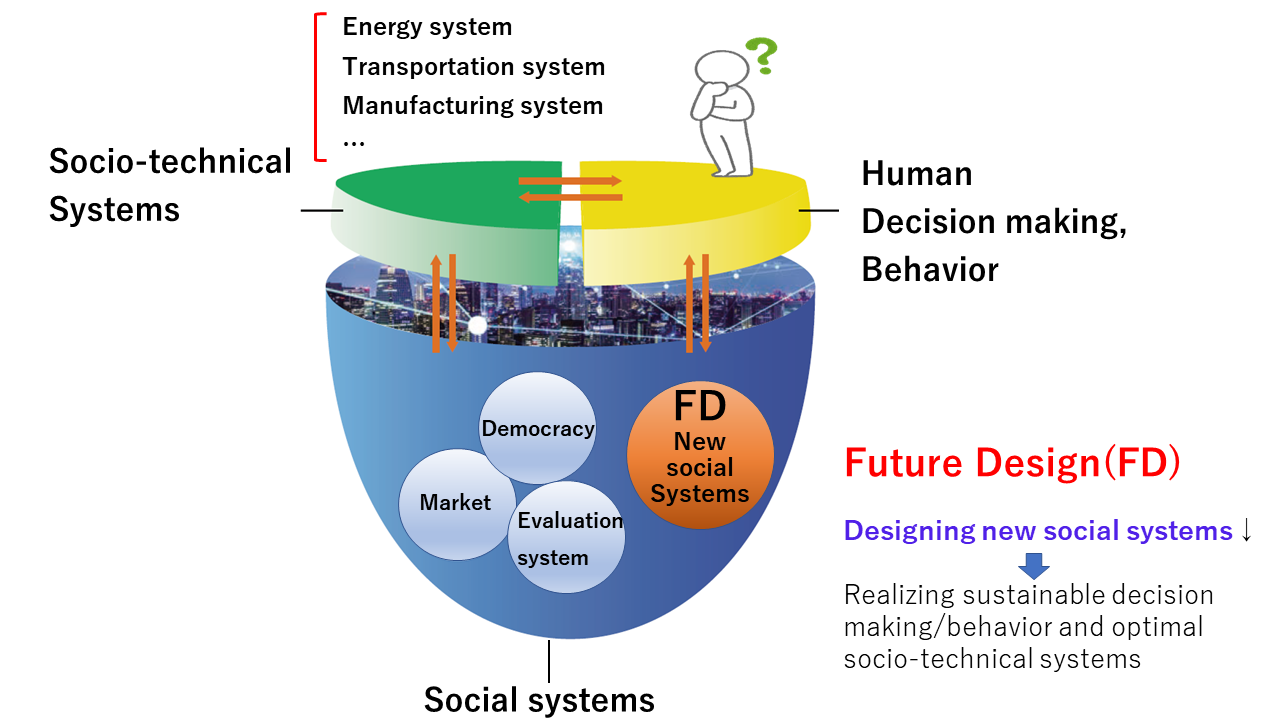
1. Deepening the Theory of Future Design and Pioneering Social Technology
Based on existing research and knowledge, we will elucidate the methodology and detailed mechanisms for sustainable decision-making and behavior that take future generations into consideration, and develop methods for intergenerational consensus building. We will then formulate optimal decision-making that is sustainable, including the time axis, and develop theories that contribute to the design of social transition processes representing the interests of current and future generations. Finally, we will build a new foundation for social engineering that explicitly incorporates the concept of "future" and considers establishing a general-purpose Future Design method as a social technology.
- Hara K, Fuchigami Y, Arai T, Nomaguchi Y, Compatible Effects of Adopting Imaginary Future Generations and Systems Thinking in Exploring Future Challenges - Evidence from a Deliberation Experiment, Futures & Foresight Science, 6(4), e191, 2024
https://doi.org/10.1002/ffo2.191 - Hara K et al., 2020, Effects of Experiencing the Role of Imaginary Future Generations in Decision-Making - a Case Study of Participatory Deliberation in a Japanese Town, Sustainability Science, in press
https://doi.org/10.1007/s11625-021-00918-x - Hara K et al., 2019, Reconciling intergenerational conflicts with imaginary future generations - Evidence from a participatory deliberation practice in a municipality in Japan, Sustainability Science, 14(6), 1605-1619
https://doi.org/10.1007/s11625-019-00684-x
2. Application and Practice of Future Design Through Co-Creation
We will apply the pioneered theories and methodologies developed by theoretical research related to Future Design to the actual social problems and promote the organization and systematization of new innovation models guided by Future Design. We will conduct vision formation, design of social transition processes through co-creation in industry, academia, and government, and conduct research that contributes to the design of social and technological systems that support a sustainable society. For example, we will apply our Future Design approach to the following themes A-C.
A)Process Design for Transition to a Carbon Neutral Society
Based on the methodology of Future Design, we will derive a vision of a carbon-neutral society by 2050 based on introducing distributed energy resources such as electric vehicles (EV) and photovoltaic (PV) power generation in urban systems. We will clarify the socioeconomic and institutional issues involved in the introduction of these technologies, and design a social transition process through consensus building among local governments, residents, and industry. In particular, we will reproduce the consensus-building process between imaginary future generations and current generations in a participatory social experiment, and identify the optimal social transition process and prioritize measures and technologies to be introduced, using data from techno-economic analysis, modeling, and simulation.
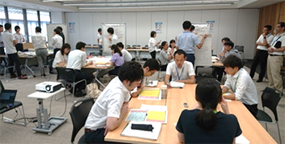
Future Design practice by Kyoto city officials for the theme of “Decarbonized society in 2050” (2019)
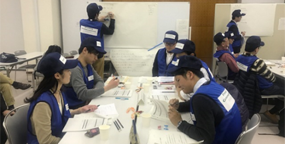
Future Design practice by Suita city (Osaka Pref.) officials for the theme of “Environmental planning” (2019)
- Hara K, Nomaguchi Y, Fukutomi S, Kuroda M, Fujita K, Kawai Y, Fujita M, Kobashi T, Policy Design by “Imaginary Future Generations” with Systems Thinking - a Practice by Kyoto City towards Decarbonization in 2050, Futures, 154, 103272, 2023
https://doi.org/10.1016/j.futures.2023.103272 - Hara K, Naya M, Kitakaji Y, Kuroda M, Nomaguchi Y, Changes in Perception and the Effects of Personal Attributes in Decision-making as Imaginary Future Generations – Evidence from Participatory Environmental Planning, Sustainability Science, 18, 2453–2467, 2023
https://doi.org/10.1007/s11625-023-01376-3 - Kobashi T et al., 2020, On the Potential of “Photovoltaics + Electric vehicles” for Deep Decarbonization of Kyoto’s Power Systems: Techno-Economic-Social Considerations, Applied Energy, 275, 115419
https://doi.org/10.1016/j.apenergy.2020.115419 - Uwasu M et al., 2020, Citizen-participatory Scenario Design Methodology with Future Design Approach: A Case Study of Visioning for Low-Carbon Society in Suita City, Japan, Sustainability, 12(11), 4746
https://doi.org/10.3390/su12114746
B)Building a Vision of Resilient Social Infrastructure and Presenting a Maintenance Management Model
By applying the concept of Future Design, we will present a sustainable infrastructure maintenance and management model that responds to sudden events such as disasters, and progressive stressors such as population decline, targeting key infrastructure for water supply, sewerage, and public facilities. By introducing a consensus-building process based on the concept of imaginary future generations, we will develop an assessment method for infrastructure maintenance and management that comprehensively reflects various factors such as vulnerability to disasters, social infrastructure, and the interests of future generations. We will also build a general-purpose prototype that can be used by other local governments, and work with them to create a framework for the continuous application of such a method.
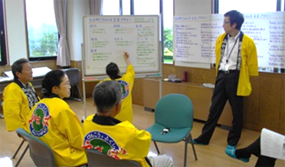
Future Design practice by citizens in Yahaba town, Iwate pref., for the theme of “Regional revitalization 2060” (2015)
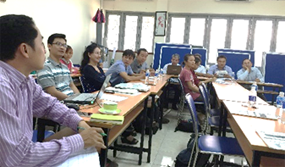
Future Design practice by stakeholders in Ho Chi Minh City, for the theme of “Water Environment and environmental infrastructure”
- Kuroda M et al., 2021, Shifting the Perception of Water Environment Problems by Introducing “Imaginary Future Generations — Evidence from participatory workshop in Ho Chi Minh City, Vietnam, Futures, 126, 102671
https://doi.org/10.1016/j.futures.2020.102671 - Hara K et al., 2020, Effects of Experiencing the Role of Imaginary Future Generations in Decision-Making - a Case Study of Participatory Deliberation in a Japanese Town, Sustainability Science, in press
https://doi.org/10.1007/s11625-021-00918-x - Hiromitsu T, Kitakaji Y, Hara K and Saijo T, What do people say when they become “future people”? ―Positioning Imaginary Future Generations (IFGs) in general rules for good decision making, Sustainability, 13(12), 6631, 2021
https://doi.org/10.3390/su13126631
C)Design of New Direction for Technology Innovation and R&D Strategy
We will apply the concept of Future Design to technology, R&D, and management strategies in industry, and present an innovative direction guided by the introduction of a "future" perspective. Through experimentation and practice and in collaboration with industry, we will pioneer and systematize new approaches and methodologies for innovating industrial technology.
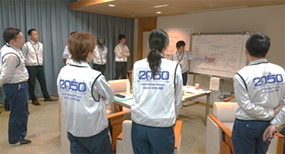
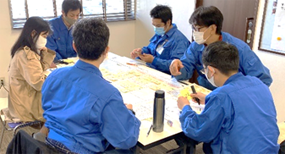
Application of Future Design into Industry for the theme of technology innovation, R & D strategy and business plan
- Hara K, Fuchigami Y, Nomaguchi Y, Kurashiki T, Eguchi M, Evaluation Criteria for R&D adopting “Imaginary Future Generations”— a Deliberation Experiment in an Engineering Company, Futures, 166, 103542, 2025
https://doi.org/10.1016/j.futures.2025.103542 - Hara K, Arai T, Liao Z, Ifuku N, Suzuki M, Designing Research and Development Strategies for Sustainable Supply Systems of Rare Metals from the Perspective of“Imaginary Future Generations”– A Participatory Deliberation Experiment, Journal of Cleaner Production, 486, 144445, 2025
https://doi.org/10.1016/j.jclepro.2024.144445 - Hara K, Miura I, Suzuki M, Tanaka T, Assessing Future Potentiality of Technologies from the Perspective of“Imaginary Future Generations”– a Case Study of Hydrothermal Technology, Technological Forecasting and Social Change, 202, 123289, 2024 (Press released)
https://doi.org/10.1016/j.techfore.2024.123289 - Hara K, Kuroda M, Nomaguchi Y, How does Research and Development (R&D) Strategy Shift by Adopting Imaginary Future Generations? - Insights from Future Design Practice in a Water Engineering Company, Futures, 152, 103221, 2023
https://doi.org/10.1016/j.futures.2023.103221


